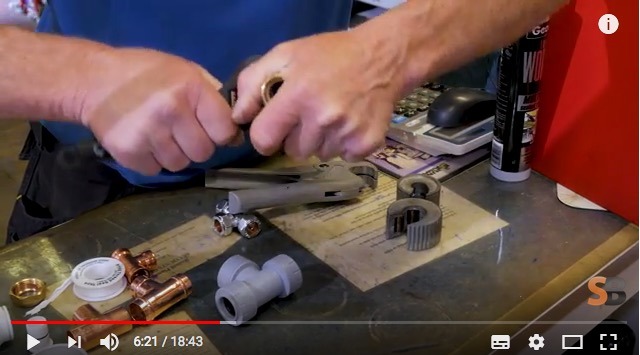Roger visits his favourite local plumber’s merchant and shows you how to join copper and plastic pipe.
There are two videos in this How to join pipes series – this, the first video, looks at how to join supply pipes – the second video will look at how to join waste pipes.
For supply pipes and central heating pipes you have a choice between good old-fashioned tried and tested copper or plastic. Plastic pipes have come a long way in the past few years and come in rolls and straight lengths and different types of plastic including PB (Polybutylene) and PEX (Cross-linked Polyethylene). Plastic offers advantages in terms of flexibility and corrosion resistance but I prefer not to use it on surface mounted pipe work, I prefer copper because it’s a lot more rigid.
Compression fittings on plastic pipe
Interestingly you can join copper and plastic with a lot of the same fittings; a lot of people don’t realise you can join a bit of plastic pipe with a compression fitting. A compression fitting works in the same way on a plastic pipe as it does on a copper pipe except that you need to put in a liner, which is there to keep the end of the pipe perfectly round. It is also there to protect the end of the pipe – when you put a push-fit fitting in there’s an O ring in there and if you don’t have the liner on, the square edge on the end of the plastic can damage the O ring and cause a leak. You might not know about it straight away but six months or even six years down the line it might develop a leak and if this causes any damage and an inspection shows the plumber neglected to put in a liner the plumber could be liable.
Once you’ve inserted the liner the nut goes over the end of the pipe followed by the copper olive and then the fitting itself. Hand tighten this and then tighten with a spanner until it’s crimped on so that the olive compresses onto the pipe. That makes a secure fitting but just for belt and braces you can take the fitting off and wrap PTFE tape around the olive – using this approach I have never had a problem.
Push-fit fittings – demountable and non-demountable
There are two types of push-fit fittings – demountable and non-demountable. JG Speedfit’s patented demountable fittings don’t require any tools to release the fittings and are truly demountable without damage to pipe or fitting.
There are many different push-fit fittings on the market but JG are, in my opinion, the best.




